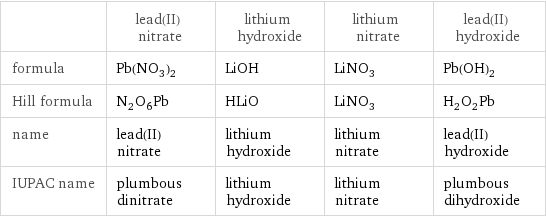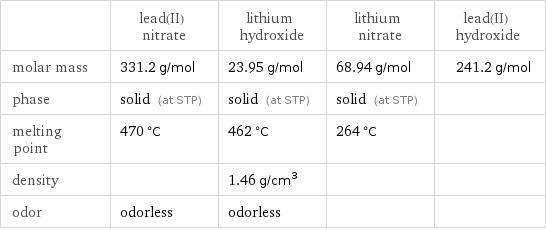Input interpretation

Pb(NO_3)_2 lead(II) nitrate + LiOH lithium hydroxide ⟶ LiNO_3 lithium nitrate + Pb(OH)_2 lead(II) hydroxide
Balanced equation

Balance the chemical equation algebraically: Pb(NO_3)_2 + LiOH ⟶ LiNO_3 + Pb(OH)_2 Add stoichiometric coefficients, c_i, to the reactants and products: c_1 Pb(NO_3)_2 + c_2 LiOH ⟶ c_3 LiNO_3 + c_4 Pb(OH)_2 Set the number of atoms in the reactants equal to the number of atoms in the products for N, O, Pb, H and Li: N: | 2 c_1 = c_3 O: | 6 c_1 + c_2 = 3 c_3 + 2 c_4 Pb: | c_1 = c_4 H: | c_2 = 2 c_4 Li: | c_2 = c_3 Since the coefficients are relative quantities and underdetermined, choose a coefficient to set arbitrarily. To keep the coefficients small, the arbitrary value is ordinarily one. For instance, set c_1 = 1 and solve the system of equations for the remaining coefficients: c_1 = 1 c_2 = 2 c_3 = 2 c_4 = 1 Substitute the coefficients into the chemical reaction to obtain the balanced equation: Answer: | | Pb(NO_3)_2 + 2 LiOH ⟶ 2 LiNO_3 + Pb(OH)_2
Structures

+ ⟶ +
Names

lead(II) nitrate + lithium hydroxide ⟶ lithium nitrate + lead(II) hydroxide
Equilibrium constant
![Construct the equilibrium constant, K, expression for: Pb(NO_3)_2 + LiOH ⟶ LiNO_3 + Pb(OH)_2 Plan: • Balance the chemical equation. • Determine the stoichiometric numbers. • Assemble the activity expression for each chemical species. • Use the activity expressions to build the equilibrium constant expression. Write the balanced chemical equation: Pb(NO_3)_2 + 2 LiOH ⟶ 2 LiNO_3 + Pb(OH)_2 Assign stoichiometric numbers, ν_i, using the stoichiometric coefficients, c_i, from the balanced chemical equation in the following manner: ν_i = -c_i for reactants and ν_i = c_i for products: chemical species | c_i | ν_i Pb(NO_3)_2 | 1 | -1 LiOH | 2 | -2 LiNO_3 | 2 | 2 Pb(OH)_2 | 1 | 1 Assemble the activity expressions accounting for the state of matter and ν_i: chemical species | c_i | ν_i | activity expression Pb(NO_3)_2 | 1 | -1 | ([Pb(NO3)2])^(-1) LiOH | 2 | -2 | ([LiOH])^(-2) LiNO_3 | 2 | 2 | ([LiNO3])^2 Pb(OH)_2 | 1 | 1 | [Pb(OH)2] The equilibrium constant symbol in the concentration basis is: K_c Mulitply the activity expressions to arrive at the K_c expression: Answer: | | K_c = ([Pb(NO3)2])^(-1) ([LiOH])^(-2) ([LiNO3])^2 [Pb(OH)2] = (([LiNO3])^2 [Pb(OH)2])/([Pb(NO3)2] ([LiOH])^2)](../image_source/dac954aa61ea03234127e152270d9811.png)
Construct the equilibrium constant, K, expression for: Pb(NO_3)_2 + LiOH ⟶ LiNO_3 + Pb(OH)_2 Plan: • Balance the chemical equation. • Determine the stoichiometric numbers. • Assemble the activity expression for each chemical species. • Use the activity expressions to build the equilibrium constant expression. Write the balanced chemical equation: Pb(NO_3)_2 + 2 LiOH ⟶ 2 LiNO_3 + Pb(OH)_2 Assign stoichiometric numbers, ν_i, using the stoichiometric coefficients, c_i, from the balanced chemical equation in the following manner: ν_i = -c_i for reactants and ν_i = c_i for products: chemical species | c_i | ν_i Pb(NO_3)_2 | 1 | -1 LiOH | 2 | -2 LiNO_3 | 2 | 2 Pb(OH)_2 | 1 | 1 Assemble the activity expressions accounting for the state of matter and ν_i: chemical species | c_i | ν_i | activity expression Pb(NO_3)_2 | 1 | -1 | ([Pb(NO3)2])^(-1) LiOH | 2 | -2 | ([LiOH])^(-2) LiNO_3 | 2 | 2 | ([LiNO3])^2 Pb(OH)_2 | 1 | 1 | [Pb(OH)2] The equilibrium constant symbol in the concentration basis is: K_c Mulitply the activity expressions to arrive at the K_c expression: Answer: | | K_c = ([Pb(NO3)2])^(-1) ([LiOH])^(-2) ([LiNO3])^2 [Pb(OH)2] = (([LiNO3])^2 [Pb(OH)2])/([Pb(NO3)2] ([LiOH])^2)
Rate of reaction
![Construct the rate of reaction expression for: Pb(NO_3)_2 + LiOH ⟶ LiNO_3 + Pb(OH)_2 Plan: • Balance the chemical equation. • Determine the stoichiometric numbers. • Assemble the rate term for each chemical species. • Write the rate of reaction expression. Write the balanced chemical equation: Pb(NO_3)_2 + 2 LiOH ⟶ 2 LiNO_3 + Pb(OH)_2 Assign stoichiometric numbers, ν_i, using the stoichiometric coefficients, c_i, from the balanced chemical equation in the following manner: ν_i = -c_i for reactants and ν_i = c_i for products: chemical species | c_i | ν_i Pb(NO_3)_2 | 1 | -1 LiOH | 2 | -2 LiNO_3 | 2 | 2 Pb(OH)_2 | 1 | 1 The rate term for each chemical species, B_i, is 1/ν_i(Δ[B_i])/(Δt) where [B_i] is the amount concentration and t is time: chemical species | c_i | ν_i | rate term Pb(NO_3)_2 | 1 | -1 | -(Δ[Pb(NO3)2])/(Δt) LiOH | 2 | -2 | -1/2 (Δ[LiOH])/(Δt) LiNO_3 | 2 | 2 | 1/2 (Δ[LiNO3])/(Δt) Pb(OH)_2 | 1 | 1 | (Δ[Pb(OH)2])/(Δt) (for infinitesimal rate of change, replace Δ with d) Set the rate terms equal to each other to arrive at the rate expression: Answer: | | rate = -(Δ[Pb(NO3)2])/(Δt) = -1/2 (Δ[LiOH])/(Δt) = 1/2 (Δ[LiNO3])/(Δt) = (Δ[Pb(OH)2])/(Δt) (assuming constant volume and no accumulation of intermediates or side products)](../image_source/b264d6a0acee9e5e8eea2715958c80c4.png)
Construct the rate of reaction expression for: Pb(NO_3)_2 + LiOH ⟶ LiNO_3 + Pb(OH)_2 Plan: • Balance the chemical equation. • Determine the stoichiometric numbers. • Assemble the rate term for each chemical species. • Write the rate of reaction expression. Write the balanced chemical equation: Pb(NO_3)_2 + 2 LiOH ⟶ 2 LiNO_3 + Pb(OH)_2 Assign stoichiometric numbers, ν_i, using the stoichiometric coefficients, c_i, from the balanced chemical equation in the following manner: ν_i = -c_i for reactants and ν_i = c_i for products: chemical species | c_i | ν_i Pb(NO_3)_2 | 1 | -1 LiOH | 2 | -2 LiNO_3 | 2 | 2 Pb(OH)_2 | 1 | 1 The rate term for each chemical species, B_i, is 1/ν_i(Δ[B_i])/(Δt) where [B_i] is the amount concentration and t is time: chemical species | c_i | ν_i | rate term Pb(NO_3)_2 | 1 | -1 | -(Δ[Pb(NO3)2])/(Δt) LiOH | 2 | -2 | -1/2 (Δ[LiOH])/(Δt) LiNO_3 | 2 | 2 | 1/2 (Δ[LiNO3])/(Δt) Pb(OH)_2 | 1 | 1 | (Δ[Pb(OH)2])/(Δt) (for infinitesimal rate of change, replace Δ with d) Set the rate terms equal to each other to arrive at the rate expression: Answer: | | rate = -(Δ[Pb(NO3)2])/(Δt) = -1/2 (Δ[LiOH])/(Δt) = 1/2 (Δ[LiNO3])/(Δt) = (Δ[Pb(OH)2])/(Δt) (assuming constant volume and no accumulation of intermediates or side products)
Chemical names and formulas

| lead(II) nitrate | lithium hydroxide | lithium nitrate | lead(II) hydroxide formula | Pb(NO_3)_2 | LiOH | LiNO_3 | Pb(OH)_2 Hill formula | N_2O_6Pb | HLiO | LiNO_3 | H_2O_2Pb name | lead(II) nitrate | lithium hydroxide | lithium nitrate | lead(II) hydroxide IUPAC name | plumbous dinitrate | lithium hydroxide | lithium nitrate | plumbous dihydroxide
Substance properties

| lead(II) nitrate | lithium hydroxide | lithium nitrate | lead(II) hydroxide molar mass | 331.2 g/mol | 23.95 g/mol | 68.94 g/mol | 241.2 g/mol phase | solid (at STP) | solid (at STP) | solid (at STP) | melting point | 470 °C | 462 °C | 264 °C | density | | 1.46 g/cm^3 | | odor | odorless | odorless | |
Units
